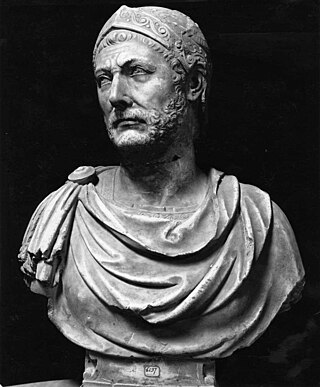
Hannibal was a Carthaginian general and statesman who commanded the forces of Carthage in their battle against the Roman Republic during the Second Punic War.
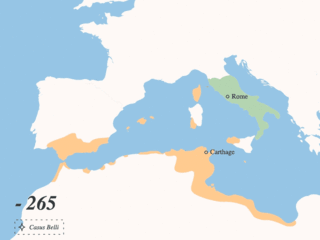
The Punic Wars were a series of wars between 264 and 146 BC fought between the Roman Republic and Ancient Carthage. Three wars took place, on both land and sea, across the western Mediterranean region and involved a total of forty-three years of warfare. The Punic Wars are also considered to include the four-year-long revolt against Carthage which started in 241 BC. Each war involved immense materiel and human losses on both sides.

The Second Punic War was the second of three wars fought between Carthage and Rome, the two main powers of the western Mediterranean in the 3rd century BC. For 17 years the two states struggled for supremacy, primarily in Italy and Iberia, but also on the islands of Sicily and Sardinia and, towards the end of the war, in North Africa. After immense materiel and human losses on both sides, the Carthaginians were once again defeated. Macedonia, Syracuse and several Numidian kingdoms were drawn into the fighting, and Iberian and Gallic forces fought on both sides. There were three main military theatres during the war: Italy, where Hannibal defeated the Roman legions repeatedly, with occasional subsidiary campaigns in Sicily, Sardinia and Greece; Iberia, where Hasdrubal, a younger brother of Hannibal, defended the Carthaginian colonial cities with mixed success before moving into Italy; and Africa, where Rome finally won the war.

The Battle of Cannae was a key engagement of the Second Punic War between the Roman Republic and Carthage, fought on 2 August 216 BC near the ancient village of Cannae in Apulia, southeast Italy. The Carthaginians and their allies, led by Hannibal, surrounded and practically annihilated a larger Roman and Italian army under the consuls Lucius Aemilius Paullus and Gaius Terentius Varro. It is regarded as one of the greatest tactical feats in military history and one of the worst defeats in Roman history, and it cemented Hannibal's reputation as one of antiquity's greatest tacticians.
The Battle of Zama was fought in 202 BC in what is now Tunisia between a Roman army commanded by Scipio Africanus and a Carthaginian army commanded by Hannibal. The battle was part of the Second Punic War and resulted in such a severe defeat for the Carthaginians that they capitulated, while Hannibal was forced into exile. The Roman army of approximately 30,000 men was outnumbered by the Carthaginians who fielded either 40,000 or 50,000; the Romans were stronger in cavalry, but the Carthaginians had 80 war elephants.

The battle of the Trebia was the first major battle of the Second Punic War, fought between the Carthaginian forces of Hannibal and a Roman army under Sempronius Longus on 22 or 23 December 218 BC. Each army had a strength of about 40,000 men; the Carthaginians were stronger in cavalry, the Romans in infantry. The battle took place on the flood plain of the west bank of the lower Trebia River, not far from the settlement of Placentia, and resulted in a heavy defeat for the Romans.

The Battle of Lake Trasimene was fought when a Carthaginian force under Hannibal Barca ambushed a Roman army commanded by Gaius Flaminius on 21 June 217 BC, during the Second Punic War. The battle took place on the north shore of Lake Trasimene, to the south of Cortona, and resulted in a heavy defeat for the Romans.

Hanno II the "Great" was a wealthy Carthaginian aristocrat in the 3rd century BC.

Hasdrubal Barca, a latinization of ʿAzrubaʿal son of Hamilcar Barca, was a Carthaginian general in the Second Punic War. He was the brother of Hannibal and Mago Barca.
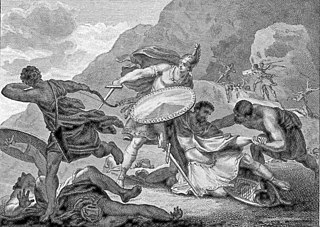
The Battle of Ticinus was fought between the Carthaginian forces of Hannibal and a Roman army under Publius Cornelius Scipio in late November 218 BC as part of the Second Punic War. It took place in the flat country on the right bank of the river Ticinus, to the west of modern Pavia in northern Italy. Hannibal led 6,000 Libyan and Iberian cavalry, while Scipio led 3,600 Roman, Italian and Gallic cavalry and a large but unknown number of light infantry javelinmen.

The Battle of Cissa was part of the Second Punic War. It was fought in the fall of 218 BC, near the Celtic town of Tarraco in north-eastern Iberia. A Roman army under Gnaeus Cornelius Scipio Calvus defeated an outnumbered Carthaginian army under Hanno, thus gaining control of the territory north of the Ebro River that Hannibal had just subdued a few months prior in the summer of 218 BC. This was the first battle that the Romans had ever fought in Iberia. It allowed the Romans to establish a secure base among friendly Iberian tribes, and due to the eventual success of the Scipio brothers in Spain, Hannibal looked for but never received reinforcements from Spain during the war.

The Battle of Ibera, also known as the Battle of Dertosa, was fought in the spring of 215 BC on the south bank of the Ebro River near the town of Ibera and was part of the Second Punic War. A Roman army, under the command of the brothers Gnaeus and Publius Scipio, defeated a similarly sized Carthaginian army under Hasdrubal Barca. The Romans, under Gnaeus Scipio, had invaded Iberia in late 218 BC and established a foothold after winning the Battle of Cissa. This lodgement, on the north-east Iberian coast, between the Ebro and the Pyrenees, blocked the route of any reinforcements from Iberia for the army of Hannibal, who had invaded Italy from Iberia earlier in the year. Hasdrubal attempted to evict the Romans in 217 BC, but this ended in defeat when the Carthaginian naval contingent was mauled at the Battle of Ebro River.
Carthalo was an officer in Hannibal's army during the Second Punic War.
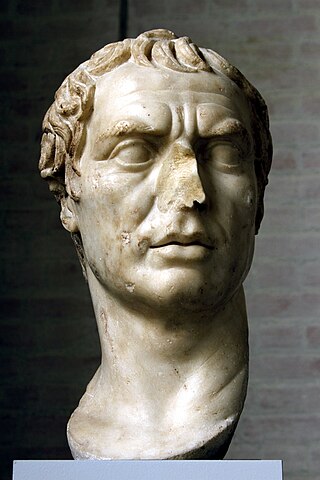
The battle of the Great Plains was fought in 203 BC in modern Tunisia between a Roman army commanded by Publius Cornelius Scipio, and allied Carthaginian and Numidian armies commanded by Hasdrubal Gisco and Syphax respectively. The battle was part of the Second Punic War and resulted in a heavy defeat for Carthage.
The Battle of Cirta was fought in 203 BC between an army of largely Masaesyli Numidians commanded by their king Syphax and a force of mainly Massylii Numidians led by Masinissa, who was supported by an unknown number of Romans under the legate Gaius Laelius. It took place somewhere to the east of the city of Cirta and was part of the Second Punic War. The numbers engaged on each side and the casualties suffered are not known.

The Battle of the Rhône Crossing was a battle during the Second Punic War in September of 218 BC. Hannibal marched on the Italian Alps, and an army of Gallic Volcae attacked the Carthaginian army on the east bank of the Rhône. The Roman army camped near Massalia. The Volcae tried to prevent the Carthaginians from crossing the Alps and invading Italy.

Ancient Carthage was an ancient Semitic civilisation based in North Africa. Initially a settlement in present-day Tunisia, it later became a city-state and then an empire. Founded by the Phoenicians in the ninth century BC, Carthage reached its height in the fourth century BC as one of the largest metropoleis in the world. It was the centre of the Carthaginian Empire, a major power led by the Punic people who dominated the ancient western and central Mediterranean Sea. Following the Punic Wars, Carthage was destroyed by the Romans in 146 BC, who later rebuilt the city lavishly.
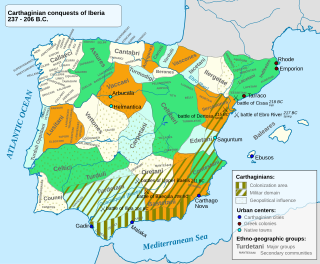
Under the leadership of the Barcid family, Ancient Carthage expanded its possessions in Iberia from 237 to 218 BC after the end of the First Punic War in 241 BC and the Mercenary War in 238 BC.
Sosylus of Lacedaemon was a Greek historian in the 3rd century BC. He would campaign alongside Hannibal throughout the Second Punic War, teaching him Greek and recording the events of his campaign.
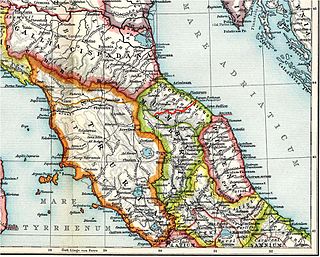
The Battle of Silva Litana was an ambush that took place in a forest 75 miles northwest of the Roman city of Ariminum during the Second Punic War in 216 BC. The Gallic Boii surprised and destroyed a Roman army under the consul-elect Lucius Postumius Albinus. Of 25,000 Romans, only 10 survived, with a few being taken prisoner by the Gauls. The corpse of Postumius was decapitated and his skull was made into a gilded ceremonial cup by the Boii. News of this military disaster probably reached Rome after the defeat at Cannae in the fall of 216 BC or the spring election of consuls for 215 BC, triggering a renewed panic. The Romans were compelled to postpone military operations against the Gauls until the conclusion of the Second Punic War, sending only two legions to guard against additional Gallic attacks. However, the Boii and Insubres did not attempt to exploit their victory. Cisalpine Gaul remained in relative peace until 207 BC, when Hasdrubal Barca arrived there with his army from Spain.
















